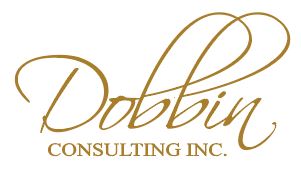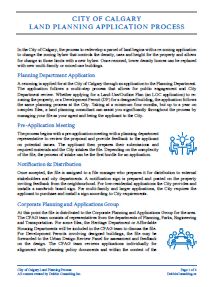City of Calgary
Land Planning
Application Process
In the City of Calgary, the land development process to redevelop a parcel of land begins with a re-zoning application to change the zoning bylaw that controls the density, uses and height for the property and allows for change in those limits with a new bylaw. Once rezoned, lower density homes can be replaced with new multi-family or mixed-use buildings.
Handout, printout, and transcript available at the bottom of page.
Planning Department Application
A rezoning is applied for at the City of Calgary through an application to the Planning Department. The application follows a multi-step process that allows for public engagement and City Department review. Whether applying for a Land-Use/Outline Plan (an LOC application) to re-zoning the property, or a Development Permit (DP) for a designed building, the application follows the same planning process at the City. Taking at a minimum four months, but up to a year on complex files, a land planning consultant can assist you significantly throughout the process by managing your file as your agent and being the applicant to the City.
Pre-Application Meeting
The process begins with a pre-application meeting with a planning department representative to review the proposal and provide feedback to the applicant on potential issues. The applicant then prepares their submissions and required materials and the City intakes the file. Depending on the complexity of the file, the process of intake can be the first hurdle for an application.
Notification & Distribution
Once accepted, the file is assigned to a file manager who prepares it for distribution to external stakeholders and city departments. A notification sign is prepared and posted on the property inviting feedback from the neighbourhood. For low-residential applications the City provides and installs a sandwich board sign. For multi-family and larger applications, the City requires the applicant to purchase and install a sign according to City requirements.
Corporate Planning and Applications Group
At this point the file is distributed to the Corporate Planning and Applications Group for the area. The CPAG team consists of representatives from the departments of Planning, Parks, Engineering and Transportation. For some files, the Heritage Department or Affordable Housing Departments will be included in the CPAG team to discuss the file. For Development Permits involving designed buildings, the file may be forwarded to the Urban Design Review Panel for assessment and feedback on the design. The CPAG team reviews applications individually for alignment with planning policy documents and within the context of the community and neighbourhood. To assist with assessments, the City may request specialist studies for items such parking impacts due to increased density.
Detailed Team Review
The result of the CPAG review is the Detailed Team Review (DTR). This is provided to the applicant and is the first formal feedback from the City with regards to the file. The applicant can then address any issues with the application that are of concern to the City and community or that fall outside of policy restrictions by negotiating relaxations.
Calgary Planning Commission
After thorough review, your file manager then generates a report to the Calgary Planning Commission and a date for the file to be presented at CPC is set. CPC is an important day for your file. The Planning Commission acts as the review panel for City Council and their recommendation is a serious consideration in the outcome of the file at the public hearing. As an applicant, you may contact CPC members to discuss your file, but CPC is not a public hearing and it is very rare for an applicant to be called upon. The Calgary Planning Commission will recommend approval or refusal in their report to Council.
Public Engagement
Throughout the process of review and preparation for CPC, your City file manager will be in contact with the Community Association and the public to gather direct feedback. In the case of multi-family and mixed-use applications, significant public engagement is required. Some developers will engage the Community Association before their pre-application meeting to get early feedback on concerns which may change aspects of the application prior to meeting with the City.
Additional public engagement must be conducted by the Applicant themselves and may include: an online website engagement portal; Community association presentations and public open houses; Councillor meetings; and additional stakeholder meetings. A land planning consultant will plan, manage, and document all public engagement throughout the application process. Throughout the planning process, the applicant or their planning consultant should strive for engagement that is ongoing, iterative, and responsive.
The feedback from engagement and the resulting application changes should be carefully documented and be shown to address stakeholder concerns. Your engagement should result in a Developer’s Engagement Report to be provided to the file manager and be included in the materials provided to both CPC and Council.
City Council Public Hearing
The ‘big day’ for your file is when you go to Council for the public hearing. The application description and CPC recommendation report and supporting materials and engagement responses are provided as supplemental materials and can include your Developer’s Engagement Report. After the file is presented the public hearing begins. All speakers are allowed 5 minutes each. First, those in favour of the approval are invited to speak, then those against approval of the application may speak. Council may ask any of the presenters’ questions once their presentation is complete.
This part of the process can make or break your application as rationales and policy knowledge are important to your responses. Once the public hearing is finished, when all speakers are done, Council may have questions on the application for Administration and then Councillors will discuss the merits and their concerns with the file.
After the public hearing and Council discussions, the application moves to vote. The process of voting for the file includes readings. If the file is approved, all three readings will be completed consecutively.
If, during Council discussions, issues or problems with the file are identified and actions are requested by Council, the application may pass first reading and then be ‘tabled’ for the second and third readings on a later date pending further engagement or negotiations. In the case of Development Permits, additional review may include assessment by the Urban Design Review Panel and the file may even be returned to CPC for further review.
Once a file returns from being tabled, hopefully with all issues addressed and acceptable changes made, the application can then pass second and third readings and be approved.
Subdivision & Development Appeal Board
If the application is for a building Development Permit (a DP), once approved by Council the application can still be challenged through an appeal process with the Subdivision & Development Appeal Board (the “SDAB”). Upon a review of the file and further public hearings, the approval may be upheld or overturned by SDAB. A qualified planning consultant and good engagement can help you avoid this outcome.
If the file is refused at Council or approved but overturned at SDAB, the applicant must wait six months to reapply with a new Development Permit Application unless substantial changes have been made to the application to address the concerns brought up through engagement and department reviews. An example of “significant changes” would be removing entire floors of a building to meet height restrictions. If a Development Permit approval is overturned at SDAB, the applicant may choose to appeal the decision at the Provincial Court of Appeal but only on aspects of law or jurisdiction.
Land-Use / Outline Plan Approval
If the development application was for Land-Use only (an LOC application) and was approved at Council, it cannot be appealed. Zoning changes are final once approved by Council. After approval, the Bylaw is signed and updated in policy documents and online records such as the MyProperty portal.
If the application was an LOC for re-zoning only, the building Development Permit can be applied for immediately upon approval of the re-zoning. The process for the building Development Permit (DP) will follow the same steps as the rezoning application through engagement, CPAG, CPC and the public hearing at Council.
Concurrent Applications (LOC + DP)
In recent years, the City has first allowed, and then encouraged, concurrent applications for Land-Use (LOC) and Development Permits (DP) to be applied for at the same time. However, the concurrent application process is not formal, and the applications may not move through the application nor reach CPC and Council together. The concurrent application approach does allow all stakeholders to have certainty of outcome and discussions about the building size, shape and public interfaces that a rezoning alone does not entail.
A concurrent application is expensive and riskier for a developer as they must design the building before gaining significant community and City feedback. Further, the developer risks the refusal of the land rezoning based on the design of the building. For this reason, developers may still choose to seek the certainty of a land rezoning approval before investing significant funds to design the building. Landowners may also seek to simply increase their land value with a rezoning to market their parcel to a developer with the rezoning completed to realize the increased value of higher density zoning.
The process for development applications can be greatly assisted by proper application management. A land planning consultant can help you by acting as your agent as the applicant to manage all public stakeholder engagement, materials management, specialist studies, public relations, and application communications.
If you would like assistance with your application, contact Dobbin Consulting today!
Additional Resources:
City of Calgary links:
Land Redesignation Info
(Rezoning Applications info)
Residential Building & Development
(Planning Department info)
Development Map
(open applications)
MyProperty Map (current zoning info)



